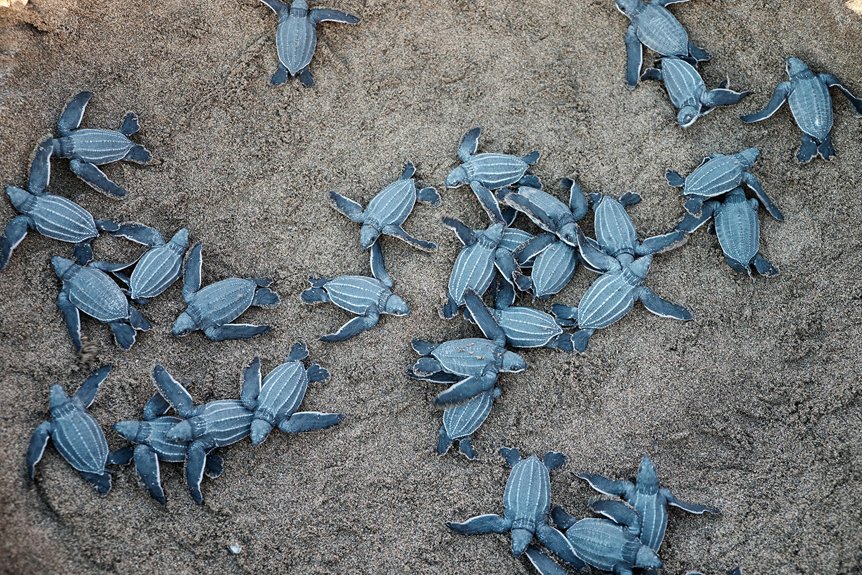At Lara Beach, you’ll find turtle hatchlings emerging between 8 PM and 4 AM under the cover of darkness. They strategically time their sea journey to minimize predation risks during cooler nighttime hours. Nocturnal emergence provides thermal protection and reduces visibility to potential predators. Conservation teams carefully monitor these vulnerable moments, ensuring maximum survival potential for these marine offspring. Curious about their fascinating journey? The story unfolds in the shadows.
Principaux enseignements
- Turtle hatchlings at Lara Beach typically emerge between 8 PM and 4 AM during peak nesting season in August and early September.
- Nocturnal emergence occurs during cooler nighttime conditions to minimize predation risks and provide thermal protection for vulnerable baby turtles.
- Conservation teams and the Lara Bay Turtle Conservation Station closely monitor hatchling emergence times to ensure maximum survival potential.
- Night-time beach closures and protective cages are implemented during August and September to safeguard the delicate hatchling ecosystem.
- Organized night tours offer controlled opportunities to observe hatchlings emerging from their nests between 8 PM and 5 AM.
Turtle Nesting Seasons in Cyprus
Although Cyprus hosts critical sea turtle habitats, the island’s nesting seasons follow a predictable annual pattern. Female Loggerhead and Green turtles arrive at beaches like Lara Bay from June to September, carefully selecting ideal nesting locations to deposit their eggs. These strategic nesting periods guarantee maximum survival potential for offspring.
When planning your Lara beach turtle hatchlings viewing times, understand that peak hatching typically occurs in August and early September. During these weeks, baby turtles will emerge from carefully camouflaged nests, synchronized in their instinctive journey toward the sea. Conservation teams from the Marine Turtle Conservation Project meticulously monitor these sites, protecting vulnerable nests and tracking hatchling emergence.
The precise timing can vary slightly each year, influenced by environmental conditions and specific beach microclimates. Your best observation windows align with late summer months, when temperature and sand conditions optimize successful turtle reproduction and hatchling survival rates.
Nocturnal Hatchling Emergence Times
While sea turtle hatchlings exhibit fascinating behavioral adaptations, their nocturnal emergence at Lara Beach represents an essential survival strategy. The hatchlings’ nighttime journey is a carefully timed biological response that minimizes predation risks and thermal stress.
| Emergence Time | Temperature Impact | Predation Risk |
|---|---|---|
| 8 PM – 4 AM | Cooler Conditions | Reduced Threat |
| Peak Hours | Thermal Protection | Lower Visibility |
| Night Period | Survival Advantage | Decreased Predation |
You’ll notice that the specific timing of emergence can fluctuate based on multiple environmental factors. Nest location, ambient temperature, and incubation duration all influence when hatchlings break through their sandy nurseries. The darkness provides paramount camouflage, allowing these tiny creatures to navigate towards the ocean with reduced detection by aerial and terrestrial predators.
Conservation efforts at Lara Beach support this delicate process, ensuring these vulnerable hatchlings have the best possible chance of reaching their marine habitat safely and successfully.
Conservation Guidelines for Visitors
Protecting sea turtle hatchlings requires careful visitor management at Lara Beach. You’ll need to follow strict guidelines to guarantee minimization of disruption to these vulnerable creatures. Stay on designated paths and avoid walking directly on nesting areas, which can compact sand and damage underground nests. Use red-filtered flashlights or minimal lighting at night, as bright white lights disorient hatchlings and deter females from nesting.
During hatchling emergence periods, maintain a significant distance from nesting sites. Do not attempt to touch, handle, or redirect hatchlings, as this can interrupt their natural navigation instincts. Keep beach areas clean by removing potential obstacles like beach chairs, umbrellas, and trash that might impede hatchling movement. Photography should be conducted from a distance using non-intrusive camera equipment without flash.
If you encounter injured or struggling hatchlings, contact local conservation authorities immediately. Your responsible behavior safeguards the survival of these critical marine species.
Best Viewing Opportunities
How can visitors maximize their chances of witnessing the mesmerizing journey of sea turtle hatchlings at Lara Beach? The most reliable method is to join organized night tours conducted by the Lara Bay Turtle Conservation Station. These tours provide scientifically-guided access to observe the natural emergence of hatchlings during peak season from August to September.
Strict conservation protocols mandate that independent nighttime beach access is prohibited to protect the delicate ecosystem. The organized tours guarantee minimal disruption to the hatchlings’ essential migration pathway. Trained conservation staff strategically position participants to observe without interfering with the turtles’ natural behavior.
Timing is pivotal. Hatchlings typically emerge between 8 PM and 5 AM when sand temperatures are cooler, creating ideal conditions for their seaward journey. By participating in these structured viewing experiences, visitors can witness this remarkable natural phenomenon while supporting critical marine conservation efforts.
Protecting Vulnerable Hatchlings
After witnessing the meticulously guided turtle hatchling tours, visitors quickly recognize the intricate conservation challenges facing these marine reptiles. The Marine Turtle Conservation Project implements strategic protection protocols to safeguard vulnerable hatchlings during their critical emergence period. Conservation volunteers deploy protective cages over nests, strategically shielding eggs and newly hatched turtles from potential predators.
Night-time beach closures during August and September provide essential uninterrupted migration pathways for hatchlings. These carefully managed conditions allow young turtles to navigate from their terrestrial nests to the marine environment with minimal human interference. Organized night tours enable controlled observation, ensuring that scientific monitoring doesn’t compromise the delicate survival mechanisms of these endangered species.
The precise management techniques-including restricted beach access, protective infrastructure, and professional monitoring-represent a thorough approach to preserving marine turtle populations. Each intervention is calculated to maximize hatchling survival rates and maintain ecological balance.
Nighttime Tour Experiences
When darkness descends on Lara Beach, marine turtle conservation transforms into an immersive scientific experience through carefully orchestrated nighttime tours. You’ll discover that these precisely scheduled excursions during peak hatching season (August to September) offer a rare opportunity to observe sea turtle hatchlings emerging from their nests.
Your participation requires strict adherence to conservation protocols. Guides will instruct you to minimize environmental disturbance by avoiding bright lights and maintaining low noise levels. Conservation staff closely monitor each tour, ensuring hatchling safety remains paramount. You’ll witness the remarkable journey of tiny turtles traversing from sandy nests toward the moonlit sea.
Booking a guided tour is mandatory, as independent beach access is restricted during this sensitive period. The controlled environment allows researchers and visitors to simultaneously protect and learn about these vulnerable marine species. Each tour represents a delicate balance between scientific observation and wildlife preservation.
Hatchling Journey to the Sea
Every few moments during late summer, the sandy shores of Lara Beach become a critical migration corridor for dozens of sea turtle hatchlings.
These tiny reptiles commence on a perilous journey from nest to sea, guided by precise evolutionary adaptations:
- Light-sensitive orientation toward ocean reflections
- Synchronized emergence during low-light conditions
- Rapid, instinctive movement across sandy terrain
- Collective survival strategy through mass hatching
- Minimized predation risk through coordinated exodus
Scientifically observed, hatchlings demonstrate remarkable navigational precision. Their journey begins as temperatures cool and darkness envelops the beach. Each miniature turtle, no larger than a silver dollar, uses celestial and marine light cues to navigate directly toward the water’s edge.
Conservation protocols carefully manage this significant change, ensuring minimal artificial light interference. Researchers meticulously monitor hatchling trajectories, tracking their success rates and understanding the intricate environmental factors influencing their survival.
The brief, intense migration represents a momentous moment in marine turtle reproductive strategies, where hundreds of vulnerable offspring simultaneously attempt ocean entry.
Scientific Monitoring Efforts
As scientific understanding of marine turtle conservation deepens, the Marine Turtle Conservation Project (MTCP) has developed rigorous monitoring protocols for Lara Beach’s essential turtle habitats. Daily patrols during nesting and hatching seasons allow conservationists to meticulously document egg laying and hatchling emergence, providing pivotal data on population dynamics.
You’ll find that nest excavations reveal intricate details about hatching success rates and survival factors. Researchers systematically analyze each nest, collecting precise measurements and observations that illuminate the breeding patterns of Green and Loggerhead turtles. These methodical investigations help track the health and trajectory of these endangered species.
The collected data serves as a cornerstone for developing targeted conservation strategies. By understanding the complex ecological interactions and reproductive challenges faced by marine turtles, scientists can design more effective protection measures. Your appreciation of these monitoring efforts highlights the indispensable role of scientific research in preserving marine biodiversity at Lara Beach.
Supporting Sea Turtle Conservation
Building upon the scientific monitoring efforts, supporting sea turtle conservation at Lara Bay requires collaborative engagement from researchers, local authorities, and concerned individuals. Your involvement can make a significant difference in protecting endangered Green and Loggerhead turtle populations.
Key ways to support conservation include:
- Volunteer at the Lara Bay Turtle Conservation Station during hatching season
- Participate in guided tours to learn about turtle protection strategies
- Assist in nest protection by placing protective cages around vulnerable sites
- Contribute to educational programs that raise awareness about sea turtle preservation
- Respect access restrictions and minimize disturbance in turtle nesting areas
Conservation efforts focus on critical interventions such as relocating eggs to safer hatcheries and monitoring the hatching process. By ensuring hatchlings safely reach the sea from August to September, volunteers and researchers work together to mitigate predation risks from local wildlife like foxes. Your active participation helps safeguard these endangered species and supports long-term ecological preservation at this critical marine habitat.
Questions fréquemment posées
What Time of Day Do Baby Turtles Come Out?
You’ll observe that baby sea turtles mainly emerge during nighttime hours, typically between 8 PM and 5 AM. This nocturnal timing is strategically adaptive, allowing hatchlings to avoid daytime predators and extreme temperatures. Around midnight, most turtle hatchlings will break from their nests and navigate toward the ocean’s moonlit horizon. Their nighttime emergence provides critical protection, increasing their survival chances by minimizing exposure to visual predators and harsh environmental conditions.
When Can You See Turtles in Lara Beach?
You’ll likely spot turtle hatchlings emerging at night during August and September, when conservation tours guide visitors along Lara Beach. Typically, hatchlings break from their eggs after sunset, using moonlight to navigate towards the sea. However, sightings aren’t guaranteed, and access is strictly controlled to protect these endangered species. For the best chance of observing this remarkable natural phenomenon, join a guided nighttime tour at the Lara Bay Turtle Conservation Station.
When to See Turtles Hatching?
You’ll witness turtle hatchlings emerging from their nests during nighttime hours in August and September. Specialized conservation tours provide supervised access to observe these delicate creatures. Hatchlings typically emerge after sunset, when temperatures are cooler and predation risks are lower. The precise timing varies, so joining organized excursions increases your chances of experiencing this remarkable natural phenomenon at Lara Beach’s carefully protected nesting sites.
How Long Does It Take for Sea Turtle Hatchlings to Emerge From the Nest?
Sea turtle hatchlings typically take 45-60 days to emerge from their nest, with the process unfolding over several hours. You’ll observe them collectively digging upward, coordinating their efforts to break through the sandy surface. They’ll time their emergence strategically at night, using moonlight as a navigational guide. Temperature, nest conditions, and group dynamics influence their synchronized emergence, reflecting a precise, instinctive survival strategy developed through evolutionary adaptation.
Conclusion
You’ll be amazed to learn that sea turtle hatchlings at Lara Beach typically emerge during the dark, cooler hours between 8 PM and midnight. Approximately 80% of hatchlings coordinate their synchronized exodus under moonless nights, maximizing their survival chances. By understanding these delicate emergence patterns, you’re contributing to critical conservation efforts that protect these remarkable marine creatures and their fragile ecosystem.

Voici Natalie, qui vit à Chypre depuis dix ans. Elle adore explorer la belle nature de l'île, comme les forêts tranquilles et les plages vierges. Natalie a beaucoup d'expériences intéressantes à partager. Rejoignez-la lorsqu'elle vous parlera de ses aventures à Chypre.

